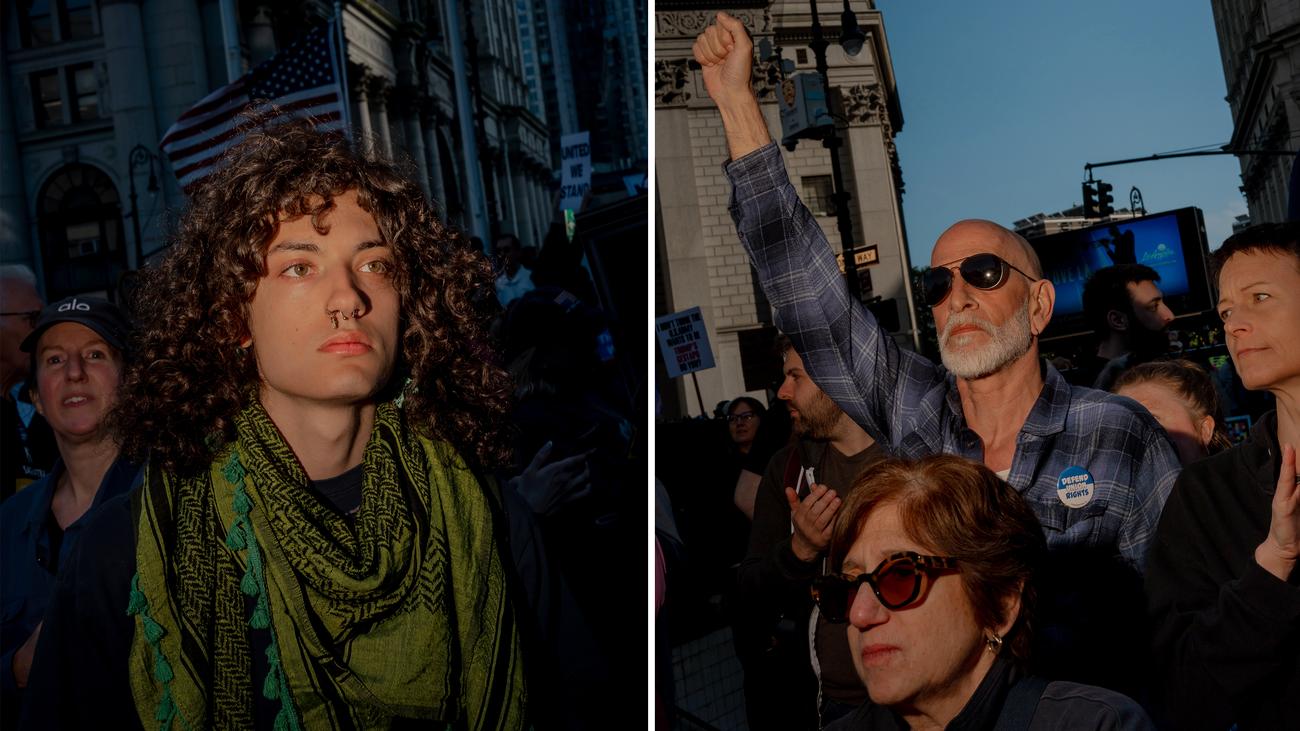
Patrick Lipscomb-Jefferson had been on his feet for seventeen grueling hours when he found himself marching south along Broadway in Manhattan, a river of humanity flowing with him on a Thursday evening. The rhythmic thump of drums echoed in the air ahead, a primal pulse urging the crowd onward. Behind him, a chorus of voices roared in unison, a defiant chant that resonated with the collective spirit of the demonstration: "This is what democracy looks like! This is what democracy looks like!" The phrase, simple yet powerful, encapsulated the purpose and passion that had drawn thousands to the streets.
Despite the long hours and the physical exertion, a question of fatigue was met with resolute denial. "Müde? No, no, no," Lipscomb-Jefferson declared, his voice carrying over the din of the protest. "Ein Gewerkschafter ist doch nie müde," he added, a touch of playful bravado coloring his statement. "A union man is never tired." However, the wry smile that played on his lips betrayed a hint of self-awareness, suggesting that while his commitment to the cause was unwavering, the sentiment about perpetual energy was perhaps a slight exaggeration.
As the protest snaked past City Hall, Lipscomb-Jefferson, fueled by a mixture of pride, anger, and determination, recounted the events of his day. His words painted a vivid picture of a life dedicated to both work and activism. The day had begun with a pre-dawn start, his shift commencing at 3:00 AM at LaGuardia Airport in Queens. There, he served as a Transportation Security Officer (TSO), a vital role within the US federal agency TSA.
After completing his demanding shift at the airport, a lesser person might have succumbed to exhaustion and sought the solace of rest. But Lipscomb-Jefferson was not one to back down from a challenge. He made his way back to his home in Harlem, a journey that would have tested the patience of even the most seasoned New Yorker. However, the thought of what lay ahead was enough to keep him focused. Once home, he quickly shed the uniform of the TSA, exchanging it for the dark blue attire that identified him as a member of the American Federation of Government Employees (AFGE), his union.
Donning the colors of his union felt like putting on armor, preparing for a different kind of battle. With his union regalia in place, he set off for the Financial District of Manhattan, the heart of corporate power and a symbolic battleground for labor rights. It was there that he joined his fellow union members and other activists, united in their shared cause.
The reason for the protest, and the source of Lipscomb-Jefferson’s simmering anger, was succinctly captured in a single, powerful statement: "Trump hat unsere Gewerkschaft gebrochen," he said, his voice tinged with frustration and indignation. "Trump broke our union. Das kann man einfach nicht akzeptieren. That’s just unacceptable."
For Lipscomb-Jefferson, the actions of the previous administration represented a direct attack on the rights and livelihoods of working people, a systematic dismantling of the protections that unions had fought so hard to secure. He saw the protest not merely as a demonstration of discontent, but as a necessary act of resistance against policies that threatened to undermine the very foundations of economic justice.
He was there, he explained, to send a message, to make a statement of defiance against what he perceived as an assault on the rights of government employees and the principles of collective bargaining. His presence, along with the thousands of others who had taken to the streets, was a tangible manifestation of resistance. It was a potent reminder that the spirit of democracy was still alive and well, that the voices of the people could not be silenced.
The march was more than just a physical act of protest; it was a symbolic expression of solidarity and resilience. Lipscomb-Jefferson, despite his weariness, found strength in the camaraderie of his fellow protestors, in the shared conviction that their collective action could bring about meaningful change. The chants, the drums, the banners – all contributed to a sense of unity and purpose that transcended individual grievances.
The experience was also a personal journey. For Lipscomb-Jefferson, it was a chance to exercise his rights as a citizen, to stand up for what he believed in, and to make his voice heard in the public square. It was an affirmation of his values, a demonstration of his commitment to social justice, and a reminder that even in the face of adversity, hope and resistance could flourish.
As the protest continued, the energy of the crowd remained palpable, fueled by a sense of shared purpose and the unwavering belief that their actions could make a difference. Patrick Lipscomb-Jefferson, despite the physical demands of his long day, continued to march, his spirit undeterred, his resolve strengthened by the collective power of the movement. He was tired, undoubtedly, but he was also energized by the knowledge that he was part of something larger than himself, a fight for a more just and equitable society. His participation was a testament to his dedication to the principles of labor rights and a powerful example of the enduring spirit of protest. He, along with the thousands marching alongside him, were the embodiment of democracy in action.
